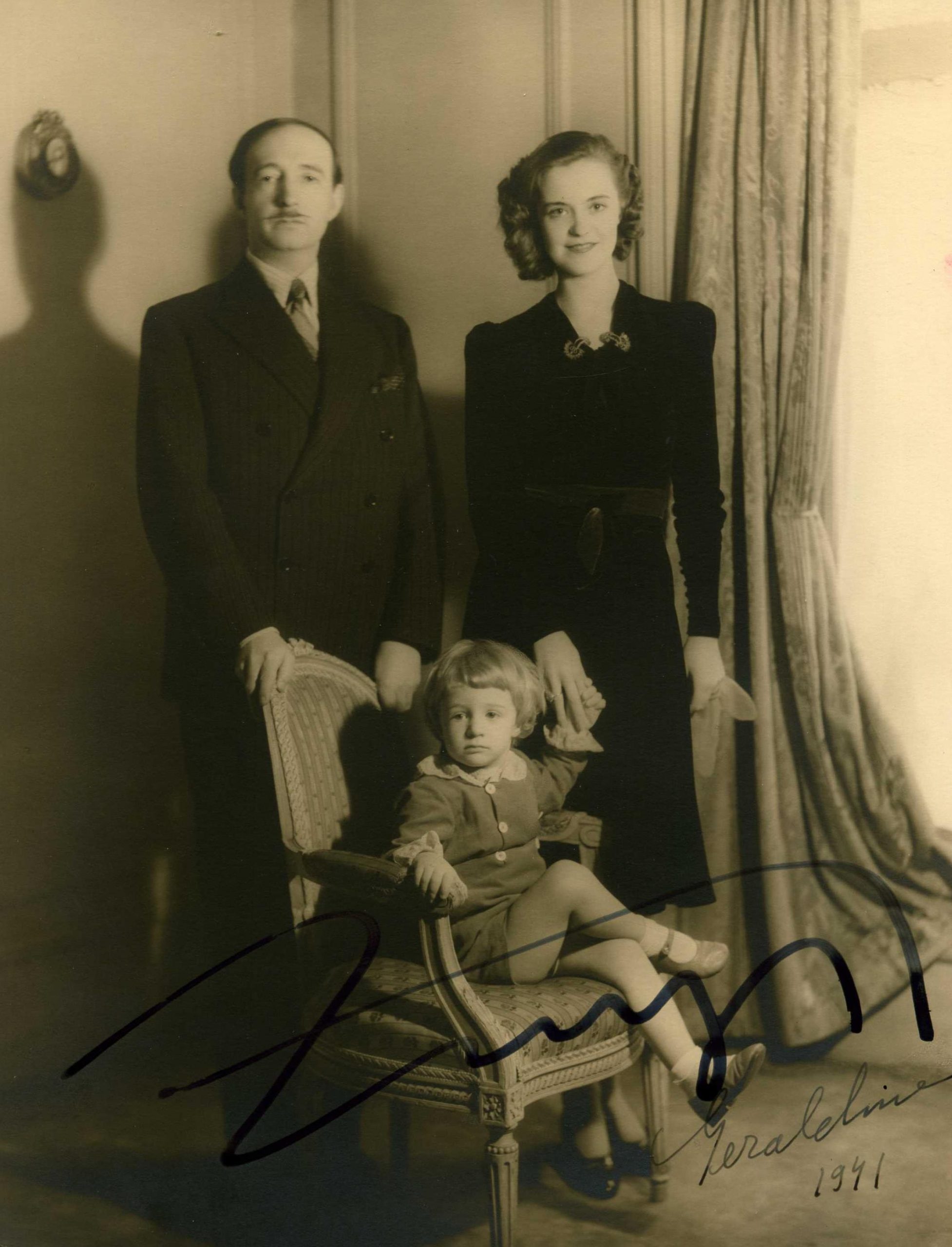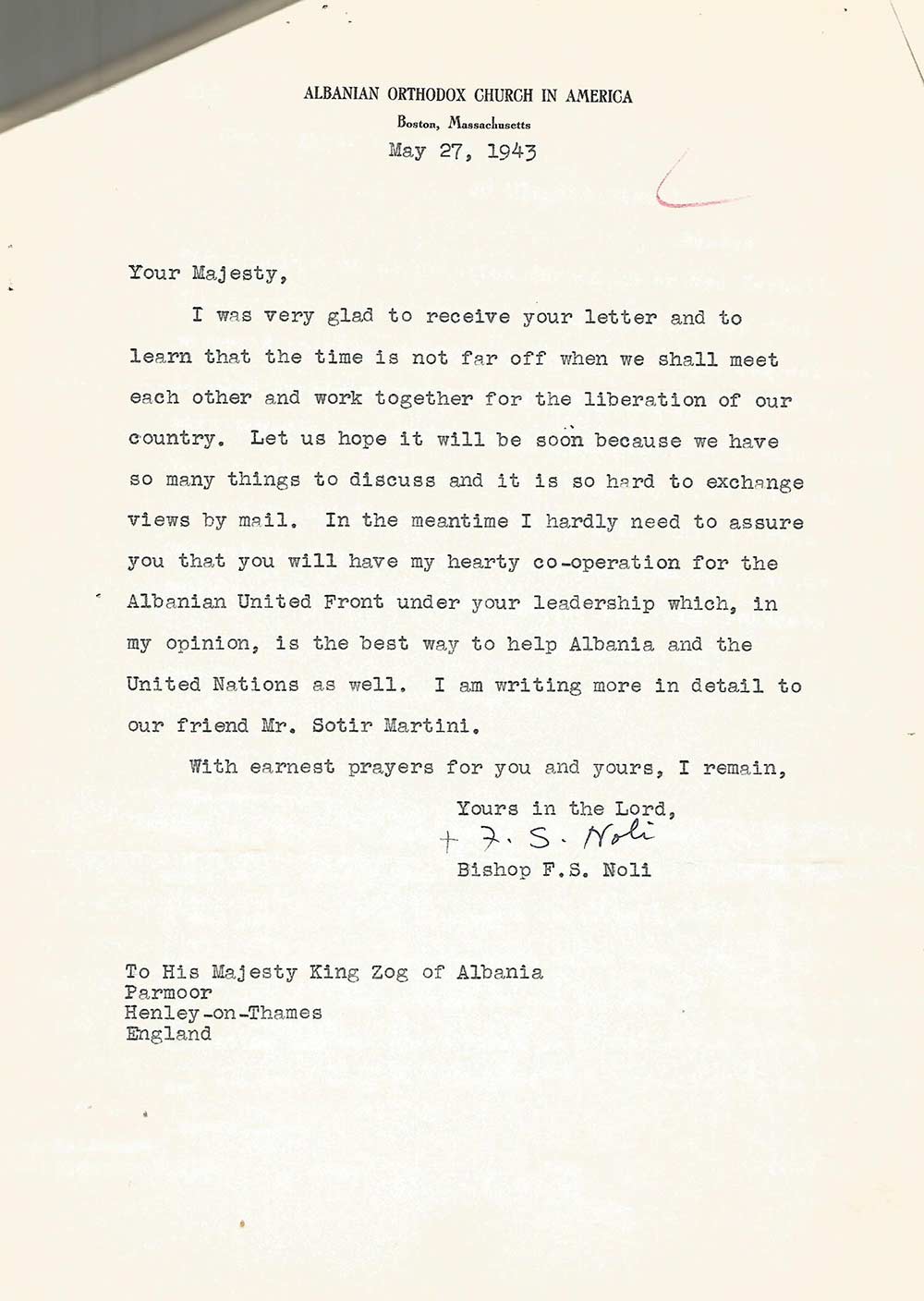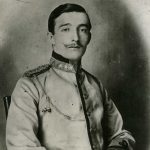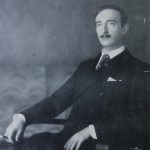Zog I, King of the Albanians
His Majesty King Zog of the Albanians was born Ahmet Muhtar Zogolli on the 8th of October 1895 in Burgajet Castle, in the Mat region. In 1922 he took the surname Zogu. He died on the 9th of April, 1961, aged 65, at Foch Hospital in Suresnes, Paris.

Zog was the third child of Xhemal Pasha Zogolli, and first son by his second wife to Sadije Toptani.
Upon his father's death in 1908, Zog became hereditary governor of the Mat region, being appointed ahead of his elder half-brother, Xhelal Bey Zogolli, by the clan council of leaders. It was his mother, Sadije Toptani, who would insist that, after his father’s death, he be educated at the Galatasaray Lyceum in Beyoglu, Istanbul. His education abroad kept him safe from the dangers of clan politics.
In 1912 Zog returned to Albania and lead a revolt of the Mat region against the Young Turks. It was during this time that Zog would battle an invading Montenegrin army in the Kakarriqi area gaining him much fame as a military leader.
On the 28 of November 1912, Zog took part in the Albanian declaration of independence, representing the Mat district. Early in 1913, Zog was forced to stop a Serbian incursion in the districts of Diber and Mat. Zog defended the region until October 1913, when the Austrian ultimatum of October 18th, demanded that the Serbs evacuate from Albania.
Albania was accepted as an independent state by the Great Powers, who established it as a Principality and canvassed for a monarch. In 1914 a German Protestant prince, called William of Wied, was appointed as prince of Albania. In 1914, Zog would support the six-month reign of Wied. He was tasked to battle rebels and retake the city of Kruja, returning it to government control. This period would be marked by a bitter rivalry with Essad Pasha Toptani. After World War I ended, William of Wied was not re-instated to the throne, which remained vacant under regency.
The Royal government was forced into exile, with over two thousand loyalists. King Zog made the decision to move to France, where he could better co-ordinate allied support to liberate Albania. The journey to France entailed a trip across free Europe, Romania (1stJuly 1939), Poland (7th July), Latvia (12thJuly), Sweden (18thJuly), Norway (23rd July), Belgium (7thAugust) and finally reaching Paris, France (8thAugust 1939) and settling in the Chateau de la Maye in Versailles.

On 27thJune 1940, the Royal Family left Bordeaux, France for England, with 35 members of the Royal Court. They escaped only 8 hours before the Germans over-ran that area of France. The British officer who co-ordinated the trip was Commander Ian Fleming, who would later become the “James Bond” author.
In London, King Zog and the Royal Family would stay at the Ritz Hotel during the German Blitz (bombing of London).This was followed by a brief stay at Forest Ridge, a house in the South Ascot area of Sunninghill in Berkshire. Then later in 1940 they moved to Parmoor House in Buckinghamshire. These many moves were necessary to avoid the bombings.
During the war years in England, King Zog would continue working for Albania’s liberation from Fascist, Nazi and Communist control. The Royal Government in exile lobbied and co-ordinated operations through Abaz Kupi and the Royal forces in Albania. King Zog went on to forge friendships with President Charles de Gaulle of Free France, as well as with General Wladyslaw Sikorski of Poland and other leaders and Royals in Exile.
In 1946 the Royal Family moved to Egypt at the behest of King Farouk, where they lived on the eastern outskirts of Alexandria, along the Corniche, at Ramleh. In 1949, just before the Arab-Israeli War, King Zog lobbied the Arab League to resist the Albanian communist regime.
In 1951 King Zog visited the United States of America and bought the Knollwood Estate in Muttontown, New York, but he never occupied the estate and sold it in 1955.
The Egyptian coup d’état of 1952 changed the situation; President Gamal Abdel Nasser made things difficult for the Royal Family in Egypt. Through the direct support of King Faisal bin Abdulaziz of Saudi Arabia and the Arab League, King Zog was given protection from the Egyptian Socialist Union.
In 1954 King Zog organized covert operations, with Anglo-American support, against the communist regime in Albania. Tragically, the missions were betrayed by a British spy, Kim Philby, who was working as a double agent for the Soviets. As a result many Royalists were captured and killed.
In July 1955 King Zog and the Royal Family returned to France to settle in Cannes. His health started to deteriorate, and any hopes of relocating to the United States of America became impossible.
H.M. King Zog passed away in Foch Hospital in Suresnes, Paris, on 9th April 1961, aged 65. He was buried at the Thiais Cemetery in Paris. On 15th November 2012, in the presence of Albanian Government representatives and an honor guard of French Legionnaires provided by the French President François Hollande, King Zog’s remains were disinterred and then returned to Albania.
On 17th November 2012, the Albanian state held an official ceremony for the reburial of His Majesty King Zog at the newly rebuilt Royal Family Mausoleum in Tirana. This was done as part of the commemoration of Albania’s independence centennial. The ceremony was attended by both the Presidents of Albania and Kosova, Government Ministers, foreign dignitaries and leaders from all the Albanian regions.
During the 1920s, Albania was experiencing extended periods of political turmoil and instability.
After the early elections on 25thAugust 1928, the parliamentary deputies from the southern region of Skrapar proposed that Albania should once again be declared a Monarchy. This proposal was accepted and taken under consideration.

A Statute Commission was created, which proposed a regime change from a Republic to a Constitutional Monarchy. This proposal was approved by a vote on 30thAugust 1928 by the Constitutional Assembly, which proclaimed Albania as a democratic, parliamentary constitutional hereditary Monarchy. A commission was then created which communicated the decision to President Ahmet Zogu, offering Zog the Throne.
On the 1st of September 1928, the Constitutional Assembly proclamation was unanimously put into effect. His Majesty Zog I, King of the Albanians, took the following oath on the Bible and Quran:
"I, Zog , King of the Albanians, on ascending the Throne of the Albanian Kingdom and assuming the Royal powers, swear in the presence of God Almighty that I will preserve national unity, the independence of the State, and its territorial integrity, and I will maintain and act conform the Constitution and Laws in force, having the good of the people always in mind."So Help Me God”!
40 Historical dates of the Royal family and King Zog









